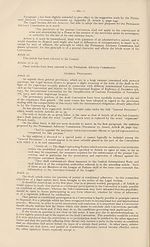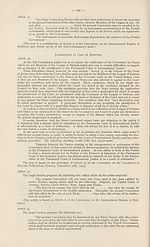Armament > Conference for the control of the international trade in arms, munitions and implements of war
(163)
Download files
Complete book:
Individual page:
Thumbnail gallery: Grid view | List view

— i6i —
By adopting these precautions the other difficulty to which the report refers would be avoided,
namely, the absence of a competent authority to determine to what extent the finality of the treaty
would be affected by partial or conditional participation. This authority would be constituted
by the States which were already parties to the Convention, and any one of them could, by
objecting, veto the limited participation proposed.
The Legal Section is not competent to decide whether it would be possible to enumerate
the actual provisions of the Convention for which restrictions could be allowed, nor can it lay
down a priori the conditions which could be accepted.
If it were not regarded as possible, the following text might be adopted:
"Any High Contracting Party may, with the consent of the other High Contracting
Parties, adhere partially or conditionally to the present Convention, provided that it
does not thereby affect the effectiveness of the supervision of the trade in arms and
munitions.
“Nevertheless, the Convention shall only apply to Powers availing themselves of
the option provided in the previous paragraph if, within the period of one year from the
notification by the French Government of the deposit of their ratification (or adherence),
no opposition to such ratification (or adherence) has been raised by any of the Con¬
tracting Parties.”
This text is a combination of Article 27 (3) of the Sub-Commission’s draft and Article 32 o^
the Geneva Convention of July 6th, 1906, for the Amelioration of the Condition of the Sick and
Wounded of Armies in the Field.
Article 28.
“All the provisions of former general international Conventions relating to the
matters dealt with in the present Convention shall be considered as abrogated in so far
as they are binding between the Powers which are Parties to the present Convention.
The Conventions referred to above include the whole of the provisions of the Convention
of St. Germain-en-Laye of September 10th, 1919, on the control of the trade in arms
and ammunition.
“The present Convention does not in any way affect the rights and obligations
arising out of the provisions either of the Convention of the League of Nations or of
the Treaty of Peace signed at Versailles on June 28th, 1919, or out of the provisions
of the other corresponding treaties, in so far as they concern the Powers which have
signed or which benefit by such treaties.”
(This new article would be substituted for Article 29 of the Sub-Commission’s draft. The
first paragraph is a reproduction of Article 25 of the Convention of St. Germain. The second is
based on Article 2 of the Convention on the International Regime of Railways, the Convention
on the Regime of Ports and the Barcelona Convention on Freedom of Transit.)
*
* *
As regards the difficulties referred to in the Report of the First Sub-Commission (Document
11, Article 29, page 131), it should be pointed out that the new Article 28 provides for the abro¬
gation of the Conventions relating to the trade in arms, while, on the other hand, by Article 4,
the Conventions on transit are left intact. As Article 28 refers to treaties on the trade in arms and
Article 4 to treaties on transit, there is no reason to fear that the abrogation provided for in
the former will affect the Conventions referred to in the latter. As we have seen, Article 4 lays
down that the Con tracting Parties intend to observe the Conventions on transit.
Lastly, as we have also seen, the new text of Article 28 explicitly states that the Convention
of St. Germain on the Trade in Arms shall be regarded as abrogated.
Article 29.
“The Council of the League of Nations shall cause to be published the annual report
on the trade in arms and munitions and the licences issued by the different Govern¬
ments.
“This report shall be submitted to the Assembly of the League of Nations.”
(this text is to replace Article 30 of the Sub-Commission’s draft.)
The amendment to this article consists in the omission of the words “of war”. The retention
of these words is calculated to restrict the scope of the provision, which appears to refer both
to arms coming under Category II, for which a licence is required, and also to arms coming under
Category I.
The words “and the situation of the trade in arms” might also be omitted, as they apparently
duplicate the first part of the first paragraph.
Article 30.
“The present Convention, of which the French and English texts shall both be
authentic, is subject to ratification. It shall bear to-day’s date and shall be open for
signature by the Powers until (date).
“Each Power shall address its ratification to the French Government, which shall
at once notify the deposit of ratification to each of the other signatory Powers.
“The instruments of ratification shall then remain deposited in the archives of the
French Government.”
(This text, which replaces Article 31 of the Sub-Commission’s draft, is based on Articles 3
and 4 of the Convention of the International Regime of Railways.)
11
By adopting these precautions the other difficulty to which the report refers would be avoided,
namely, the absence of a competent authority to determine to what extent the finality of the treaty
would be affected by partial or conditional participation. This authority would be constituted
by the States which were already parties to the Convention, and any one of them could, by
objecting, veto the limited participation proposed.
The Legal Section is not competent to decide whether it would be possible to enumerate
the actual provisions of the Convention for which restrictions could be allowed, nor can it lay
down a priori the conditions which could be accepted.
If it were not regarded as possible, the following text might be adopted:
"Any High Contracting Party may, with the consent of the other High Contracting
Parties, adhere partially or conditionally to the present Convention, provided that it
does not thereby affect the effectiveness of the supervision of the trade in arms and
munitions.
“Nevertheless, the Convention shall only apply to Powers availing themselves of
the option provided in the previous paragraph if, within the period of one year from the
notification by the French Government of the deposit of their ratification (or adherence),
no opposition to such ratification (or adherence) has been raised by any of the Con¬
tracting Parties.”
This text is a combination of Article 27 (3) of the Sub-Commission’s draft and Article 32 o^
the Geneva Convention of July 6th, 1906, for the Amelioration of the Condition of the Sick and
Wounded of Armies in the Field.
Article 28.
“All the provisions of former general international Conventions relating to the
matters dealt with in the present Convention shall be considered as abrogated in so far
as they are binding between the Powers which are Parties to the present Convention.
The Conventions referred to above include the whole of the provisions of the Convention
of St. Germain-en-Laye of September 10th, 1919, on the control of the trade in arms
and ammunition.
“The present Convention does not in any way affect the rights and obligations
arising out of the provisions either of the Convention of the League of Nations or of
the Treaty of Peace signed at Versailles on June 28th, 1919, or out of the provisions
of the other corresponding treaties, in so far as they concern the Powers which have
signed or which benefit by such treaties.”
(This new article would be substituted for Article 29 of the Sub-Commission’s draft. The
first paragraph is a reproduction of Article 25 of the Convention of St. Germain. The second is
based on Article 2 of the Convention on the International Regime of Railways, the Convention
on the Regime of Ports and the Barcelona Convention on Freedom of Transit.)
*
* *
As regards the difficulties referred to in the Report of the First Sub-Commission (Document
11, Article 29, page 131), it should be pointed out that the new Article 28 provides for the abro¬
gation of the Conventions relating to the trade in arms, while, on the other hand, by Article 4,
the Conventions on transit are left intact. As Article 28 refers to treaties on the trade in arms and
Article 4 to treaties on transit, there is no reason to fear that the abrogation provided for in
the former will affect the Conventions referred to in the latter. As we have seen, Article 4 lays
down that the Con tracting Parties intend to observe the Conventions on transit.
Lastly, as we have also seen, the new text of Article 28 explicitly states that the Convention
of St. Germain on the Trade in Arms shall be regarded as abrogated.
Article 29.
“The Council of the League of Nations shall cause to be published the annual report
on the trade in arms and munitions and the licences issued by the different Govern¬
ments.
“This report shall be submitted to the Assembly of the League of Nations.”
(this text is to replace Article 30 of the Sub-Commission’s draft.)
The amendment to this article consists in the omission of the words “of war”. The retention
of these words is calculated to restrict the scope of the provision, which appears to refer both
to arms coming under Category II, for which a licence is required, and also to arms coming under
Category I.
The words “and the situation of the trade in arms” might also be omitted, as they apparently
duplicate the first part of the first paragraph.
Article 30.
“The present Convention, of which the French and English texts shall both be
authentic, is subject to ratification. It shall bear to-day’s date and shall be open for
signature by the Powers until (date).
“Each Power shall address its ratification to the French Government, which shall
at once notify the deposit of ratification to each of the other signatory Powers.
“The instruments of ratification shall then remain deposited in the archives of the
French Government.”
(This text, which replaces Article 31 of the Sub-Commission’s draft, is based on Articles 3
and 4 of the Convention of the International Regime of Railways.)
11
Set display mode to:
![]() Universal Viewer |
Universal Viewer | ![]() Mirador |
Large image | Transcription
Mirador |
Large image | Transcription
Images and transcriptions on this page, including medium image downloads, may be used under the Creative Commons Attribution 4.0 International Licence unless otherwise stated. ![]()
| League of Nations > Armament > Conference for the control of the international trade in arms, munitions and implements of war > (163) |
|---|
| Permanent URL | https://digital.nls.uk/195383882 |
|---|
| Shelfmark | LN.IX |
|---|
| Description | Over 1,200 documents from the non-political organs of the League of Nations that dealt with health, disarmament, economic and financial matters for the duration of the League (1919-1945). Also online are statistical bulletins, essential facts, and an overview of the League by the first Secretary General, Sir Eric Drummond. These items are part of the Official Publications collection at the National Library of Scotland. |
|---|---|
| Additional NLS resources: |
|

